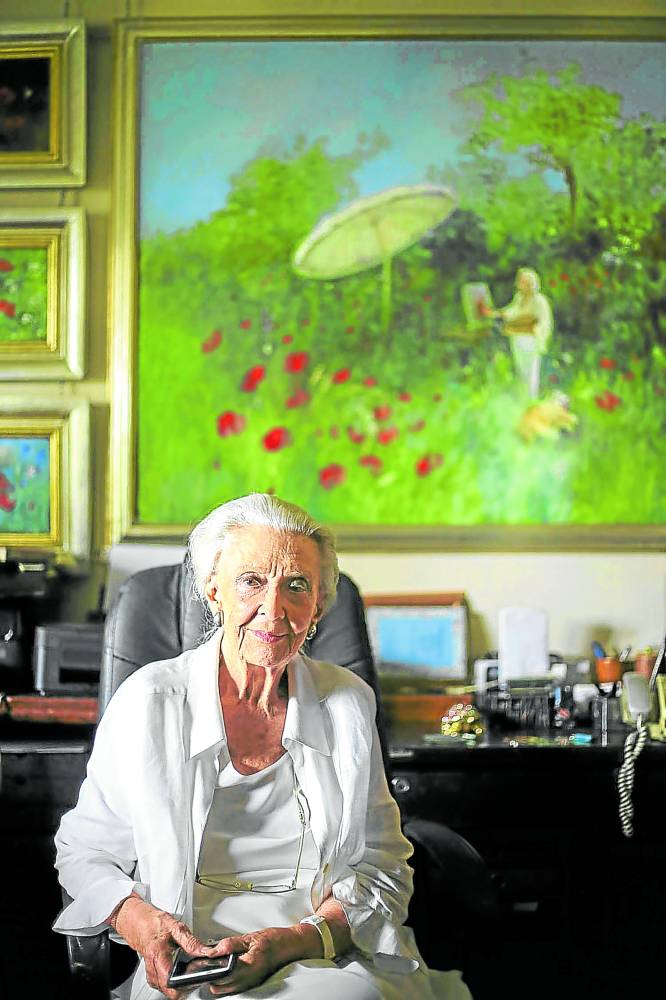
Betsy Westendorp has produced throughout her extensive career a body of work wherein three thematic blocks have clearly taken precedence—portraits, flowers, and the heavens (atmospherographs)—although we must not forget her landscapes, both rural and urban (the terraces of Madrid).
The fact of her having been a portrait painter for high society in Madrid and Manila, with the connotations that this may entail (mellow portraits), perhaps makes it difficult to perceive the psychological acuity of many of her portraits, in which the painter scanned the soul of the person painted.
What was astonishing was Westendorp’s certainty and confidence in the relationship between her brain and her hand. She never made preliminary sketches but painted directly on the canvas, a canvas that in many cases had wall dimensions. In the words of her daughter, Carmen Brías, a painter herself and an art restorer, her mother’s methodology when painting portraits was the same as that of the scanner. She went from top to bottom, from left to right, producing the portrait with a mechanical order, which nevertheless—like the scanner—did not mechanically reproduce the surface of the object but its interior composition, in this case its soul, its essence.
Best portraits
Her best portraits are those of women with character, of advanced age. That of the Cartagena-born Carmen Conde is extraordinary, at the age of 78; her own self-portrait in 2012, already 85 years old then; or that of Mercedes Zóbel de McMicking, the great matriarch of the Ayala empire. Also, without forgetting that of Gloria Zóbel de Padilla, or of Elena Flórez.
It is a pity that the commissions for these types of portraits were understandably the fewest because Westendorp reached the level of a great portrait painter in them. Only the face matters (and the pearls that underline it) in these portraits of women with character, omitting or outlining everything else.
In her paintings of flowers—orchids, hydrangeas and water lilies—Westendorp developed what would be the essential characteristic of her painting, that intuitive mastery of color. There is nothing better than the floral universe to indulge in chromatic experimentation—suppressed, linked to the real appearance of flowers and plants, but with the necessary freedom to explore new realities in what will be the beginning of the path towards abstraction. Her painting career tended towards abstraction without fully reaching it.
Total freedom
This statement is evident in her atmospherographs, a term very well applied by the critic Elena Flórez (a science that describes the air that surrounds the earth through images, drawings or sketches) to the pictorial series that began to be revealed when Westendorp settled near Manila Bay, to capture the sublime beauty of its sunsets.
With the skies of Manila, freedom for Westendorp reached its highest splendor—that freedom that made her understand painting as a separate discipline from drawing, in which color is everything. Sky is the limit of abstraction. That freedom led her to face those large paintings, without an ounce of fear of the huge blank canvas.
Westendorp was to the sky of Manila what Constable was to the English sky. When analyzing her atmospherographs, it is also inevitable to refer to William Turner, “the painter of the ethereal, of the inapprehensible, who thanks to his great capacity for observation, his patience and his discipline, has been considered as the painter of water, of fire, of the sky. He managed to feel the impalpable and transmit it in a poetic language.” This statement by Berta Lucía Estrada could be well applied to Westendorp’s airbrushes, with the nuance that in many of them we find a Mediterranean warmth more typical of Monet or Sorolla.
It is most probable that Westendorp arrived at Turner’s site in some of her atmospherographs, going somehow the reverse path that realists and impressionists traveled. Not in vain Javier Barón, curator of the exhibition “Turner y los maestros,” affirms: “Turner influences movements that go from realism to abstract expressionism.”And it remains curious that Westendorp was on this path towards abstraction in a city as corporeal, as tangible and as concrete as Manila, where life boils, in a country where many Spaniards end up finding themselves. —Contributed INQ
The author is the director of Instituto Cervantes de Manila.